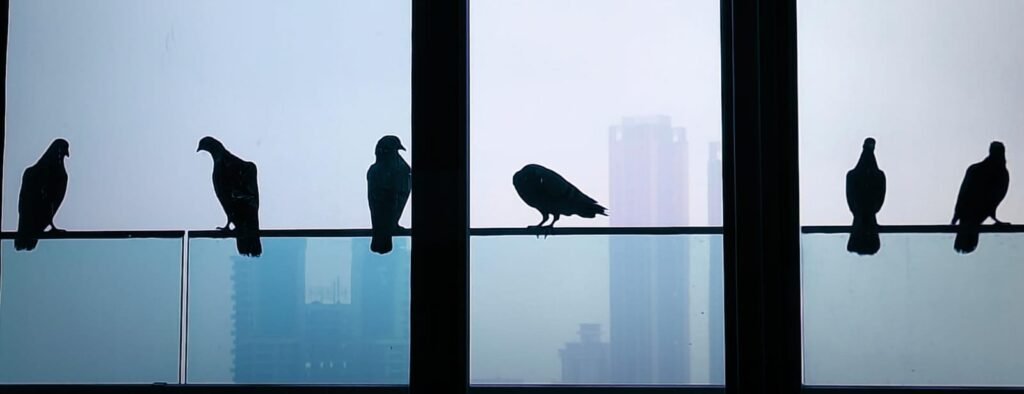
On Monsoons, Murakami, and a Boy Named Mahala
Selina Sheth
“Rain has the power to hypnotize,” writes Haruki Murakami in his dream-like novel South of the Border, West of the Sun. “Look at the rain long enough, with no thoughts in your head, and you gradually feel your body falling loose, shaking free of the world of reality.” So feels Murakami’s protagonist Hajime, who at first is indifferent to Japan’s magical season of cool showers. But then one summer, the rain rekindles an old flame and complicated feelings of regret and desire in the thirty-something narrator. On a wet, stormy night in the late 1980s, in a moment that could put Casablanca to shame, a mysterious woman from Hajime’s past appears in his life and unsettles his orderly present. This is Hajime’s childhood love Shimamoto, who he last saw at elementary school two decades before.
*
The early 1960s. In a small town near Tokyo, pre-teen schoolboy Hajime makes friends with a new classmate, Shimamoto. She walks with a slight limp but to Hajime, this handicap only serves to make Shimamoto more alluring. They spend rainy afternoons listening to Nat King Cole records on Shimamoto’s father’s LP player. As the crooner of South of the Border imagines Mexico, Hajime fantasizes about what lies under Shimamoto’s skirt even though they never go beyond holding hands.
In time, Hajime casually – and by his own admission, cruelly – abandons Shimamoto. He moves to another suburb, makes new friends at his new school, has sex with a string of attractive girls, attends college in Tokyo, struggles for a while and eventually marries a wealthy young woman whose father bankrolls Hajime’s dream of opening a bar. Hajime transforms into a prosperous entrepreneur and the father of two girls. He has it all, he believes, until a grown-up Shimamoto, “bringing with her the scent of the rain,” walks into his establishment one night and into a spot in his heart that has never quite been filled over the years.
Hajime’s story, with its tender, haunting texture of romance, fantasy, loss and heartbreak, unnerves me. Can the rain be a thing of beauty? In Mumbai, where I live, the monsoon is as synonymous with destruction as it is with poetry; and famed for its annual legacy of flooded tenements, clogged drains, sunken cars and uprooted trees. In Delhi, where I grew up, the rain is soft and humid, a sensation I will forever associate with back-to-school nerves, itchy clothes and flat hair. In the western cities I’ve visited – Munich, London, Paris, New York – what falls from the sky feels like a million icy crystals piercing my skin, a symbol of cold endings rather than new beginnings.
But this year, after months of pandemic-induced social isolation, I welcome the rain lashing against my windows. Perhaps my newfound romanticism is linked to the adult reunion of Hajime and Shimamoto and the atmospheric rhythm of Murakami’s words. Or maybe, like a female version of Hajime, I am again that twelve-year old sixth grader at New Delhi’s International School who on a wet July morning encountered a new classmate: a boy named Mahala.
*
The monsoon term of 1984 began with a thunderstorm, a volley of rain and the smell of damp naphthalene. Our grey classroom walls matched the overcast clouds outside; from our desks by the bay windows, we could see the sodden football field on one side and the dripping nets of the basketball court on the other. Our young class teacher Ms. Khosla smiled as she introduced us to the lanky boy beside her. Almost regal in his posture, his skin the color of roasted coffee, his blue jeans and Bob Marley T-shirt giving him an instant stamp of coolness: this was Mahala, from Lusaka, the Republic of Zambia. He would be joining us for a few months, maybe longer. His English was a bit weak but he could catch up quickly enough if one of us volunteered to help. Ms. Khosla added that Mahala was an ace athlete who had offered to coach the girls’ basketball team. Then somebody whistled, causing Mahala to grin broadly, mime a dribble down the aisle, and smoothly plonk himself down on the empty chair at the end, right next to me.
As July washed into August and then September, Mahala and I bonded naturally. On days it wasn’t raining, he joined my friend Annika and I while we practiced lay-up shots during recess. After school, we shared a double-seat on the South Route school bus and an umbrella for the short walk from the Vasant Vihar C-Block bus stop to my house in D Block. If it was a Friday, we headed to Mahala’s in E, where we raced through lunch and the hour of English conjugation that I’d been assigned to tutor him in. Sometimes Mahala’s grandmother, who he called Ibo, made us sticky rice pudding. Ibo was a vision in her flowing kaftans and the striking necklace of ivory and copper that she always wore. The piece was a family heirloom, said Ibo, who told us that she was a descendant of the Bantu tribe: her forefathers had come to Zambia through the Eastern sea-route via the African Great Lakes. Mahala rolled his eyes at Ibo’s stories. Ibo whacked him when he did this, telling her grandson that just because he was learning English, he was not to forget his own language, Nyanja, or to have respect for his elders.
When the rain stopped mid-afternoon, Mahala and I climbed up to the roof deck to hear mixed tapes: Prince’s ‘Purple Rain’, Michael Jackson’s ‘Thriller’ and Mahala’s stash of Zambezi rock, a mix of African beats and guitar riffs that was all the rage in Lusaka’s youth clubs. Mahala missed home, but he thought New Delhi was pretty exciting too.
Some days we rode our bikes around the neighborhood. We pedaled over the chaotic ‘colony’ streets, expertly dodging cars and autorickshaws, and on weekends, made stops at the main market to check out the new comics at Sardarji’s general store. Mahala loved Sardarji’s turban, which reminded him of the one his long-dead grandfather liked to wear in cool weather. After hearing this, Sardarji gave Mahala a free Commando every Saturday morning.
On weekdays, Mahala had to be back home at sharp 6 p.m. That was when his mother returned from her job at the Zambian High Commission. Mrs. Irene Muziya, the newly-appointed Second Secretary of Accounts in New Delhi, was pretty, quiet, shy; the antithesis of fierce, dramatic Ibo.
By October, the monsoon was over and Mahala and I found ourselves bored of our usual haunts. One Tuesday afternoon, as we lolled about in the park opposite my house, Mahala asked what lay beyond the park’s barbed wire boundary wall. I mumbled that it was just a jungle, the kind of overgrown forest area that dotted many of the city’s suburbs. I didn’t add that my parents had warned me never to enter it. But with Mahala I felt reckless, in the mood for adventure; besides, I’d always wanted to know what mysteries the jungle held, and what other places it led to.
And so Mahala and I jumped over the boundary wall, a feat that gave us scratchy elbows and bleeding knees. Not that we cared. Once within the cool dark forest, we followed a sandy-orange trail through thick trees and thorny shrubs – moving silently at first, then talking of school, of Ms. Khosla’s boyfriend Samir who played in a hippie band called Raga Fusion, and of Annika’s crush on Mahala. My Zambian friend always shrugged when the subject of Annika’s one-sided love came up, and more than once, had implied that he preferred girls like me.
We had been walking and talking for more than an hour when we realized that we’d drifted onto another path and that all paths looked the same. Now, a few steps away from us, was a baoli, a large stone reservoir that looked like it had been carved out of the earth. Mahala peered over it, intrigued at how the baoli plunged deep into thick, mossy-green water. Its walls bore intricate sculptures of dancing girls, animals and birds. We were studying Humayun’s reign in History, and wondered if this could be a Mughal-era royal bath? The kind that might have existed if this jungle were a kingdom filled with palaces and emperors? Could the reservoir have been a pit for wild animals? Or a watery dungeon for drowning robbers and bandits?
That’s when it started to rain. Within seconds, a light drizzle turned into cascading torrents of water. It’s a freak shower, I told Mahala, the kind that could happen after the monsoon at this time of year, just before the cold Delhi winter set in. We heard a roar of thunder, and jumped as the grey sky split with the zigzag of lightning. Oily water started to swirl in the depths of the reservoir. Mahala and I found shelter under a thick low clump of bushes, and huddled together under an abandoned plastic sheet. It was dark and the wind howled. I stammered aloud my mother’s warning – that the jungle held roving groups of thieves, and worse, maybe even jackals, jackals who howled like the wind.
Mahala wasn’t worried at all. He smiled as the rain crashed around us and told me how, in the southern parts of Africa, the wet season arrived between November and April and sometimes, far more violently. Two years earlier, at the peak of the monsoon in February, Mahala and his father visited Victoria Falls and watched in awe as sheets of water smashed into the Zambezi river. The Muziyas’ divorce had just been finalized, and this was the first outing father and son had taken together. A few weeks later, Mahala’s father remarried and soon had another boy, Mahala’s half-brother. Mahala had not seen his father after their day at Victoria Falls because Dad was busy with his new family; besides, Mahala’s mother didn’t really like it when Mahala asked to see his father. It made her sad.
Mahala spoke of how the divorce was the reason Mahala’s mother had taken a short-term posting in India: she was tired of Lusaka. Irene Muziya had applied for a US work permit and wanted to emigrate to midwestern America, where she had a cousin and where she believed Mahala would have a better life than in Zambia.
I didn’t want to think about the possibility of Mahala leaving Delhi. But before I could reply, Mahala stood up, looked around and then yelled triumphantly. The rain was gentler now and Mahala pointed to a glow of light in the distance that we could follow. A low throb of sound – music, voices – seemed to be coming from that direction. Perhaps it was a village.
We began to walk. I trailed Mahala as he strode through haphazard paths, a thick branch in his right hand to swipe away thorns and leaves.
And then we were there. The light was no village; what we had stumbled upon was the National Highway. It gleamed before us like the Promised Land. Trucks and vans whizzed past, their headlights a blurry yellow against the rain. Across the highway, looming over a cluster of ramshackle mechanic shops, hardware stores and a dhaba, an electric signboard flashed that Palam Airport lay just 1.5 kilometers ahead.
*
From the dhaba, I dialed home from a clunky metal pay phone. (I’d found a one-rupee coin whilst fishing in my drenched pockets, but I feared this stroke of good luck would not extend to my father being in a good mood.)Mahala joked that we could always board an airplane at Palam and fly far away. We laughed hysterically, at the absurdity of the day and where it had brought us. The dhaba owner brushed past us then – his gaze lingering on my sodden clothes, on Mahala who still held his weapon-like branch – and muttered ‘kaala’ at him in a low, crude tone. Mahala stopped laughing and inched closer to me by the phone. I prayed he hadn’t understood, but Mahala’s face had clouded over in that split second, as if he had always understood.
*
Twenty minutes later, my father picked us up in his blue ambassador. Accompanying him was a grim-faced Ibo. We drove home to Vasant Vihar; Mahala and I hunched on the backseat like two newly-arrested prisoners on their way to incarceration. It was raining again and the windshield wipers moved furiously back and forth. To lighten the tension, my father slipped an old Beatles tape into his cranky Phillips car stereo. Ibo cracked a faint smile despite herself, but Mahala was expressionless. Maybe he was worried about what his mother would say. Or maybe the magic of this afternoon had been tainted for other reasons.
*
Mahala and I got the mandatory punishment: we were grounded for two weeks which meant No Going Anywhere But School. The next morning, Mahala was not in class. I assumed he was late and that we’d talk at recess, but that day there was no recess. Mid-morning, an announcement was made that we were all to go home immediately. Prime Minister Indira Gandhi had been shot.
I didn’t see Mahala again. School stayed shut as the capital plunged into street violence and strict curfew. I heard my parents talking about the Prime Minister’s assassination, and then about Sardarji, whose brother had been killed in an anti-Sikh riot near Old Delhi’s Kashmiri Gate.
When school reopened in early December, Mahala, his mother and Ibo had already left India. At Christmas, I received a letter with a US postal stamp. Mahala wrote that he liked Ohio and was finding school easy thanks to the English skills he’d picked up in Delhi. Enclosed in the envelope was a polaroid photo of us eating Ibo’s rice pudding on Mahala’s roof, and taped to it was a single ivory and copper bead. I wondered if Mahala had stolen it from Ibo’s jewelry box, and imagined the look on Ibo’s face if that were true. It was only later that I noticed Mahala’s letter offered no return address.
In the spring of 1985, I turned thirteen. By the next monsoon, I thought less of Mahala and more of another boy from my Chemistry class. We were now allowed to attend school dances, which was more exciting than riding bicycles or exploring jungles. Since then, many monsoons have come and gone.
*
Unlike Hajime and Shimamoto, I doubt Mahala and I are destined to meet again. I have tried to find him – sporadically, and out of curiosity, every five years or so – using Google Search on the internet but there is no online or social media for Mahala. Maybe he has changed his name. I wonder if he stayed in America or eventually returned to Zambia; and if Ibo and his mother are still alive; or if one or both have passed, like my father did three years ago. It was raining on that September day when we immersed Papa’s ashes in flowing river water so that they would be taken out to sea, and where perhaps they might have evaporated, become cloud, and burst forth again as teardrops of rain.
I put the story of Hajime and Shimamoto aside and stand by the open window. It’s evening and a fresh shower of Mumbai’s notorious rain turns my terrace plants into electric green; in the distance, the Arabian Sea churns into a mass of indigo blue. The earth, parched by summer heat and the misery of Covid-19, will rejuvenate.
I start to understand the rain as Murakami does. Rain as the recycler of memory. Rain as the silent witness of every moment. Rain as the holder of every secret. Rain with its power to hypnotize. As Hajime wonders whether Shimamoto was ever real or only a figment of his imagination, I remember the day Mahala and I walked through a wet, dark forest, and how the city airport suddenly appeared before us like a spaceship, a neon illusion. Today, that moment feels like the last chapter of our innocence – an innocence that I have since lost completely – and it is as Hajime describes when he recalls Shimamoto: “The two of us alone, beneath a glimmer of light, our hands clasped tightly together, for a fleeting ten seconds of time.”
*












